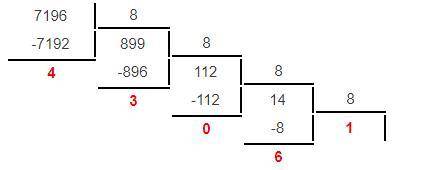PL/SQL is a modern, block-structured programming language. It provides several features that make developing powerful database applications very convenient. For example, PL/SQL provides procedural constructs, such as loops and conditional statements, that are not available in standard SQL.
You can directly enter SQL data manipulation language (DML) statements inside PL/SQL blocks, and you can use procedures supplied by Oracle to perform data definition language (DDL) statements.
PL/SQL code runs on the server, so using PL/SQL lets you centralize significant parts of your database applications for increased maintainability and security. It also enables you to achieve a significant reduction of network overhead in client/server applications.
1) 15342 2) 16034
Объяснение:
Для этого переведем его сначала в десятичную вот так :
1AE216 = 1∙16^3+10∙16^2+14∙16^1+2∙16^0 = 4096+2560+224+2 = 688210
Получилось: 688210
Переведем 688210 в восьмеричную систему вот так:
Целая часть числа находится делением на основание новой
(см. картинку)
Получилось: 688210(десятеричная) = 153428 (восьмеричная)
2)Для этого переведем его сначала в десятичную вот так :
1C1C16 = 1∙16^3+12∙16^2+1∙16^1+12∙16^0 = 4096+3072+16+12 = 719610
Получилось: 719610
Переведем 719610 в восьмеричную систему вот так:
Целая часть числа находится делением на основание новой
(см. картинку 2)
Получилось:719610 (десятеричная) = 160348 (восьмеричная)


71*35*50*1 = 124250 байт ≈122 Кбайта
если 1 символ кодируется 16-ю битами (2 байта), тщ:
71*35*50*2 = 248 500 байт ≈ 243 Кбайта
(1 Кбайт = 1024 байта)